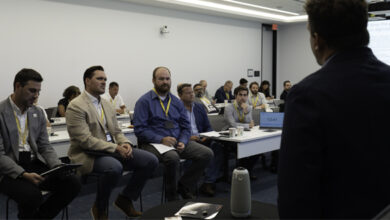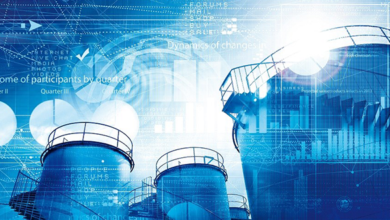Digital twins drive remote monitoring, integrity management
Virtual models of physical assets are not new, but industry is finding new ways to leverage them on drilling rigs and in the wellbores they drill
By Stephen Whitfield, Associate Editor
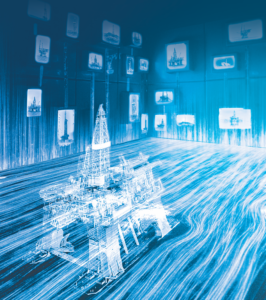
It is nearly impossible to talk about the rise of digitalization in drilling today without mentioning digital twins. As many already know, a digital twin is a virtual representation of a physical asset, like a drilling rig or a well, designed to help users understand or predict the asset’s performance. Essentially, it is a digital link to the physical world, incorporating all of the engineering, behavior and knowledge of an asset. If done right, it can help operators and drilling contractors to drive greater efficiencies in the operation and maintenance of rigs and wells, lowering costs and making processes safer.
- Digital twin software is being deployed to visualize wellbore and drilling process statuses in real time, creating opportunities to reduce NPT and improve drilling rates.
- New approach to FEAs, already used on FPSOs and fixed platforms, can enable constant modeling of operational conditions on a rig throughout its lifecycle.
- Smart applications based on digital twins can upload data from physical assets into a cloud infrastructure, allowing for advanced diagnostics to be done remotely.
“With a digital twin, we can model something in real time that shows us what should happen in the well right now,” Morten Svendsen, Chief Technology Officer at eDrilling, said in an online presentation on 24 June. “We can see where the real-time measurements from the well deviate from the model. We can get diagnostics from the well. That allows us to detect problems that are starting to occur, have occurred or may occur in the future. By doing that, we can look ahead: What is going to happen in the well if we continue to do what we’re doing right now?”
In April, eDrilling won a contract to integrate its well construction planning software into Total’s Drilling Engineering Software Kit (T-Desk), a proprietary engineering software platform for well design and drilling operations.
Around the same time, China National Petroleum Corp (CNPC) also contracted eDrilling’s well planning software suite to support operations on the Tarim field in the Xinjiang Uyghur region in northwest China. The software will be used for simulations on dynamic multiphase hydraulics and temperature, including managed pressure and dual-gradient drilling, advanced well control and torque and drag.
“We are using dynamic models driven by real-time data flow. It’s not the steady-state simulations that might have been done well ahead of the operation. This is actually done during the operation itself, so it is easy to compare and measure data. You set up the system to gauge whatever’s important for the operation of the well that’s actually being drilled,” Mr Svendsen said.
In June, eDrilling and WellSpec, an engineering advisory company, also announced a joint venture to study the use of wellSim, an eDrilling technology, in MPD and high-pressure, high-temperature scenarios. This dynamic downhole simulator platform allows for the integration of client-specific well data in early well planning, effectively creating a virtual wellbore.
Improving performance
Since 2017, eDrilling and Russia’s Gazprom Neft have been collaborating on a Drilling Management Center (DMC) to help the operator increase performance and reduce nonproductive time (NPT). Real-time surface and downhole drilling data, plus well configuration data, are used to visualize the wellbore and drilling process in real time.
Since the DMC’s inception, Gazprom Neft has seen annual reductions in NPT between 8% and 10% and improvements in its drilling rate at 20%, according to eDrilling.
At the IADC/SPE International Drilling Conference in March, the companies presented a case study of a well where digital twin software was used to automatically calculate hook load values. This eliminated the need for real-time support from engineers, who would normally have to check this information at each connection.
The case study also discussed the use of digital twin software for controlling tripping speed in a well with narrow pressure margins and wellbore instability issues. To build a reliable geomechanical model for this well, eDrilling developed equivalent circulation density (ECD) limits and applied them to the digital twin software configuration to control ECD fluctuations in real time. Due to a big annular clearance and low mud flow rate, the well had a high probability of pack-off. To prevent this, the digital twin used data from the annular pressure while drilling sensors and modeled the back-reaming process so it would achieve maximum speed.
The digital twin also helped calculate surge-and-swab pressure during tripping in/out to avoid pressure peaks from the pipe moving too fast, which could have led to losses and problems with borehole stability.
By determining maximum speeds in these areas, digital twins helped Gazprom Neft optimize tripping speed and back-reaming velocity within safe limits and control ECD fluctuations in real time, while also minimizing borehole stability issues.
Earlier this year, DNV GL issued an international call to oil and gas operators and the supply chain to pilot a methodology that will prove whether the data generated by digital twins can be trusted and if the technology is delivering value.
Companies manufacturing hardware must prove the safety, quality and integrity of components, equipment and assets through recognized quality assurance principles. However, no standard process exists to provide the same mechanism of trust and value for digital twins.
DNV GL said it is developing and testing a methodology for the qualification of digital twins. An initial partnership with TechnipFMC has led to the creation of the pilot, which is now being opened to the wider industry.
DNV GL’s Technology Outlook 2030 report highlights a digital value chain run by machines and algorithms as a prevailing trend in the coming decade. According to the report, cloud computing, advanced simulation, virtual system testing, virtual/augmented reality and machine learning will progressively merge into full digital twins that combine data analytics, real-time and near real-time data on installations, subsurface geology and reservoirs.
“Solving the digital trust challenge will be key to the dramatic evolution that we expect to see in digital twin technology in the years to come,” said Liv A. Hovem, CEO of DNV GL – Oil & Gas. “If more sophisticated digital twins are to be widely accepted and developed at scale by the oil and gas industry, they need to be supported by accurate, valuable and trusted technology. Technology decision makers in our sector will increasingly offer support to the use of digital twins when they see the systems provide consistent, accurate information which brings tangible value against the investment needed.”

System monitoring
Siemens has been involved in digital twin software for the past two decades, since the company moved into the industrial software space through a series of acquisitions. In 2014, the Walkinside system was added to its COMOS plant engineering software for authoring two-dimensional data. The system enables the use of three-dimensional engineering data to provide what it calls an immersive training model, where multiple avatars can perform virtual walkthroughs, red-lining and commentary on various processes within an asset.
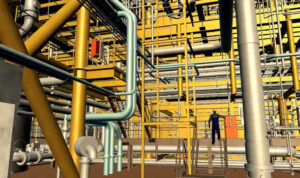
The system can be useful for companies managing assets, like a drilling contractor and its rigs. “This is a software we use to offer the technical information – diagrams, lists about the processes in a system, about the electrical, single-line diagrams, multi-line diagrams, control groups – and generate the automation code directly, giving information that can be used in the maintenance and operation of an asset,” said Iiro Esko, Chemical Industry Manager at Siemens.
Digital twins can also provide noticeable benefit in remote monitoring and maintenance activities. Smart applications can upload data to a cloud infrastructure, allowing for real-time monitoring of multiple assets, each of which are modeled by digital twin software.
“We use remote connectivity to be able to have almost a dashboarding feature where you get a real-time picture on how an asset is currently performing,” said Jonas Norinder, Digitalization Manager, Process Automation at Siemens. “You could have advanced diagnostics to manage various parameters and look at how those they develop together. That can be done remotely once you connect to the asset. However, if there is a digital twin of that asset, you can have a service technician looking at a 3D drawing of a specific component, for instance, which provides a lot more detail to make troubleshooting more efficient.”
A digital twin provides a centralized data capture unit that can essentially run parallel to a rig’s network and alert companies to potential maintenance issues, Mr Esko explained.
“You can have algorithms looking at the data, and you only need to look at it when there’s a deviation from the parameters set in those algorithms,” Mr Esko said. “We can control the system based on what the AI and machine learning algorithms detect on the cloud. In theory, if you can control the system with the algorithms, you could control the physical asset remotely without local operators.”

Mr Svendsen mentioned this kind of monitoring capability with eDrilling’s software, which is available in a traditional client-server architecture, where the software performs calculations while connected to a physical server, as well as with the option of running a scalable system in the cloud. A cloud architecture allows users to adapt their simulations over a large spread.
“For larger organizations, which might have two wells today or 10 wells on another day, it’s very easy to scale up or scale down the amount of resources and the number of users you need to analyze data in the cloud,” Mr Svendsen said.
Structural integrity
The conventional tool for performing structural integrity analysis of an asset, like a rig, is the finite element analysis (FEA), which divides a large system into smaller systems (finite elements). Mathematical equations help predict the behavior of each element, and a computer adds up each behavior to predict the behavior of the full asset. FEAs help to predict how an asset can react to real-world forces, like vibration and fluid flow.
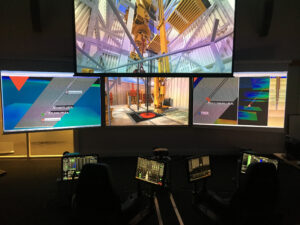
Building off of this concept, tech developer Akselos took a component-based approach and developed a model based on reduced basis finite element analysis (RB-FEA) that would help to optimize structural analysis on large-scale assets.
The RB-FEA is a type of reduced order model (ROM), which allows users to build large, high-fidelity, complex models. Unlike a traditional FEA approach that can deliver high fidelity only locally, the RB-FEA model breaks down an asset – a rig, for example – into smaller components. These components are then used to create a full, high-fidelity model, which Akselos says is a much faster process than using FEAs. The model can then be used online in operations.
Mat Podskarbi, Vice President Americas at Akselos, described the model as an enabler for physics-based digital twins of critical assets that could model various operational conditions and could be used throughout its lifecycle. The RB-FEA can solve large and complex models in a matter of seconds and support updates to the model based on sensor and inspection data from the asset. This capability is optimal for supporting structural digital workflows, he added.
The RB-FEA model is also a key enabler for a digital thread, a data-driven architecture that links information generated from across a product’s lifecycle. Using a digital thread through the lifecycle of an asset – the concept, design, manufacturing, operations and decommissioning phases – allows users to immerse design and operational decisions in data, Mr Podskarbi said. An important element of the digital thread is a digital representation of the asset that can be constantly updated to closely reflect current conditions at any given time – something to which the RB-FEA model is better suited than other structural analysis methods, he added.
“A traditional approach creates a worst-case scenario and designs for that,” he continued. “It is good, sound engineering, but today’s technology allows for managing risk more efficiently. With a digital twin powered by RB-FEA, you can expand the design space and account for many orders of magnitude more of actual scenarios. This leads to better risk management and more economical design.”
An example of Akselos’ application is a digital twin of an entire FPSO, using its model to provide structural analyses of hulls and topsides based on up-to-date sensor and inspection data from the asset. However, the RB-FEA technology can be utilized wherever critical assets are deployed in harsh conditions, Mr Podskarbi explained.
Two years ago, the company presented a paper at OTC, outlining the use of the system on a semisubmersible. The hull model used to test the RB-FEA model included 400,000 FEA degrees of freedom, the maximum amount that a traditional FEA can handle. The RB-FEA technology enabled a full-time domain fatigue analysis of the rig, which was previously impossible because of the significant amount of time needed to perform every calculation using a conventional FEA software program. Actual sensor measurements of platform motion and wave data can be used to perform detailed fatigue assessments.
Akselos believes the work it’s done on FPSOs and fixed platforms are directly applicable to drillships and jackups. Mr Podskarbi said: “There are many applications of RB-FEA that are possible in a drilling context.” DC




